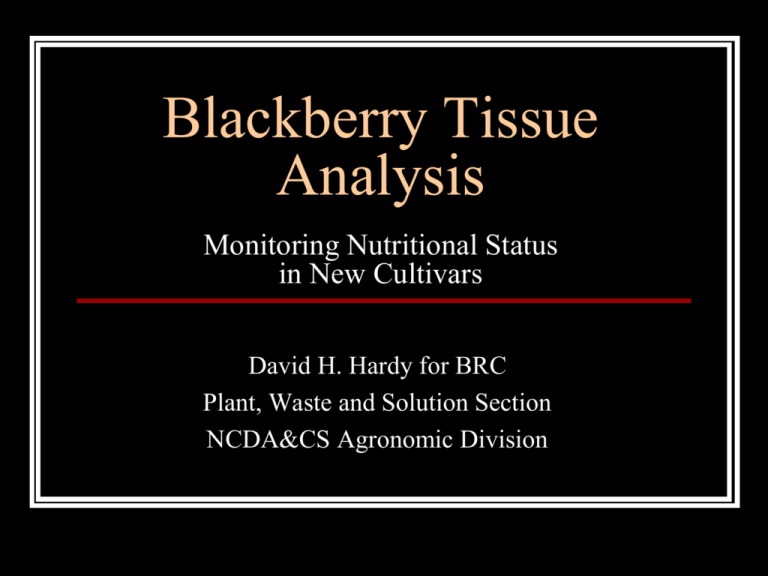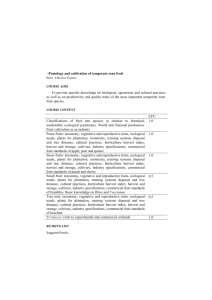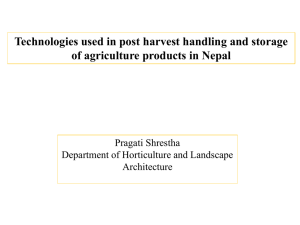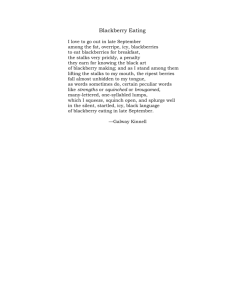Blackberry Tissue Analysis
advertisement

Blackberry Tissue Analysis Monitoring Nutritional Status in New Cultivars David H. Hardy for BRC Plant, Waste and Solution Section NCDA&CS Agronomic Division Blackberry Acreage in NC 1999: < 100 acres 2002: about 150 acres 2006: SunnyRidge Farm, Inc., indicated desire to expand production by 5-700 A Blackberry and raspberry 2009: about 400 acres Future growth still expected Blackberries – Yum!!! Blackberry (Rubus) Perennial root; biennial shoots Primocane is vegetative; 1st year growth (no flowers or fruit) Floricane is reproductive; 2nd year growth flowers, fruits then dies and is pruned out Erect, semi-erect, trailing, semi-trailing New Cultivars Erect and semi-erect Thornless Different harvest times Navaho, Ouachita (others include Apache, Chester, Hull, Triple Crown, Arapaho, Chickasaw, Kiowa & Choctaw) Cultivars suited to NC are currently being developed. Cultivar Characteristics Navaho Erect Univ. Arkansas Thornless Mid-late season Med-high yield Great postharvest shelf life (PHSL) Ouachita Erect Univ. Arkansas Thornless High yields Big berries, great flavor Good PHSL NC State University, AG 697-W, 2008 New Fertilization Practices Currently, growers are more likely to spoon-feed soluble fertilizer through drip tape in addition to broadcasting or banding fertilizer. New Fertilizer Recommendations For mature blackberries: 60–80 lb N Spring: drip a total of 50 lb N 15 lb N March 1 10 lb N March 15, April 1, and April 15 5 lb N early May Post harvest: apply remainder of N Fall: no nitrogen; lime and nonnitrogenous fertilizers as needed NCDA&CS Recommendations Developed primarily for trailing blackberry Provided micronutrient recommendations Current Lime & Fertilizer Lime to pH 6.0 March: Apply 40 lb N, 40 lb P2O5, 80 lb K20 July: Apply 60–80 lb N Current NCDA&CS Sufficiency Ranges for Blackberry (for trailing blackberry, primocane, mid season) Nitrogen Phosphorus 3.0–4.0% 0.2–0.6% Potassium 2.5–3.5% Calcium 0.5–1.0% Magnesium 0.2–0.4% Sulfur 0.2–0.6% Sufficiency Ranges from Clark NABGA (1997) Developed for newer cultivars Collected from the primocane in August (or 2 weeks post harvest) 30–60 most recently mature leaves Nitrogen 2.4–2.9% Phosphorus >0.15% Potassium 1.0–2.0% Calcium >0.5% Magnesium >0.3% Sulfur >0.13% Iron >50 ppm Manganese >50 ppm Zinc >20 ppm Copper >7 ppm Boron 30–50 ppm 2006 July, Bramble Production Workshop with SunnyRidge Farm, Inc. November, Bramble Discussion with Gina Fernandez, David Hardy and Brenda Cleveland Update recommendations for new cultivars and production practices We want big, sweet, berries with great shelf life How Should We Start? Develop a baseline of plant sufficiency ranges Focus on primocane, post harvest Stabilized, stored N (Bernadine & Strik, 2008) Follow with fertilization tests Plant Tissue Analysis—2007 & 2008 Canes (2) Growth stage (4) Cultivars (2) Locations (from eastern to western NC) Most recently mature leaves (MRML) 2007 Easter Freeze Cane Primocane is vegetative; 1st year growth (no flowers or fruits) Floricane is reproductive; 2nd year growth flowers, fruits then dies and is pruned out CSIRO Australia by peterb Growth Stages Early (E): pre bloom Bloom (B): full bloom Fruit (F): ripe or harvesting fruit Mature (M): 2 weeks post harvest Sample Type Predictive – monitor nutritional status Diagnostic – verify if problems are related to poor nutritional status Locations Coastal Plain, east & west Piedmont & Mountain Cleveland: 2 Commercial Growers Granville: Oxford Tobacco Research Station Henderson: 1 Commercial Grower Lincoln: 4 Commercial Growers Nash: 1 Commercial Grower Rowan: Piedmont Research Station Cooperating Growers Soil pH ranged from 6-6.5 Good fertilization practices Tissue samples collected from healthy canes that were not stressed Samples Collected Navaho Ouachita Floricane Primocane Floricane Primocane 49 46 49 48 Tissue Sample Results Average macronutrients concentrations (N, P, K, Ca, Mg, S) 2008 Average Nitrogen 4.5 Navaho-P Ouachita-P Navaho-F Ouachita-F 4 3.5 %N 3 2.5 2 N>2.4-2.9% Clark 1997 1.5 Early Bloom Fruit Growth Stage PostHarvest 2008 Average Phosphorus 0.30 Navaho-P 0.28 Ouachita-P 0.25 Navaho-F Ouachita-F 0.23 0.20 %P 0.18 0.15 0.13 P>0.15% Clark 1997 0.10 Early Bloom Fruit Growth Stage PostHarvest 2008 Average Potassium 1.2 Navaho-P Ouachita-P Navaho-F Ouachita-F 1.1 1 0.9 0.8 %K 0.7 0.6 0.5 K>1.0-2.0% Clark 1997 0.4 Early Bloom Fruit Growth Stage PostHarvest 2008 Average Calcium 1.2 1.1 1 0.9 0.8 % Ca 0.7 0.6 0.5 0.4 0.3 Navaho-P Ouachita-P Navaho-F Ouachita-F Early Bloom Fruit Growth Stage PostHarvest Ca>0.5% Clark 1997 2008 Average Magnesium 0.55 Navaho-P Ouachita-P Navaho-F Ouachita-F 0.5 0.45 % Mg 0.4 0.35 0.3 0.25 Early Bloom Fruit Growth Stage PostHarvest Mg>0.3% Clark 1997 2008 Average Sulfur 0.25 Navaho-P 0.23 Ouachita-P Navaho-F 0.20 Ouachita-F % S 0.18 0.15 0.13 0.10 Early Bloom Fruit Growth Stage PostHarvest S>0.13% Clark 1997 Summary & Direction Range (min/max) of Nutrient Concentrations in the Post Harvest Primocane Samples Nutrient % concentration (baseline study) Nitrogen Phosphorus Potassium Calcium Magnesium Sulfur 2.0-3.3 0.13 – 0.26 0.5 – 1.3 0.3 – 1.0 0.25 – 0.50 0.13 – 0.20 Average Nutrient Concentrations in the Post Harvest Primocane Samples Nutrient Nitrogen Phosphorus Potassium Calcium Magnesium Sulfur % concentration % concentration (baseline study) (Clark, U. Ark, 1997) 2.4 – 2.9 0.17 – 0.18 0.77 – 0.84 0.51 – 0.68 0.30 – 0.38 0.15 – 0.15 2.4 – 2.9 >0.15 1.0 – 2.0 >0.5 >0.3 >0.13 In the Future Fertilization research Develop soil fertility recommendations to optimize yield of new cultivars Develop new plant tissue sufficiency ranges continue baseline study (2009) cultivars differences which canes/growth stages predict fertilizer needs fine-tune nutrient management








